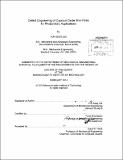Defect engineering of cuprous oxide thin-films for photovoltaic applications
Author(s)
Lee, Yun Seog
DownloadFull printable version (11.71Mb)
Alternative title
Defect engineering of Cu₂O thin-films for photovoltaic applications
Other Contributors
Massachusetts Institute of Technology. Department of Mechanical Engineering.
Advisor
Tonio Buonassisi.
Terms of use
Metadata
Show full item recordAbstract
Thin-film solar cells are promising for renewable-energy applications due to their low material usage and inexpensive manufacturing potential, making them compatible with terawatts-level deployment. Cuprous oxide (Cu₂O) is an earthabundant semiconductor with desirable properties for light-absorbing layers. However, power conversion efficiencies of solar cells comprising this absorber material remain significantly below the theoretical limit. In this thesis, I utilize novel materials and device geometries to engineer defects in Cu₂O thin-films and overcome the low power-conversion-efficiency of Cu 20-based solar cells. First, nitrogen doping is proposed as an effective p-type doping method to control optical and electrical properties of Cu₂O thin-films. The film's p-type conductivity is elucidated by temperature-dependent Hall effect measurements and a compensated semiconductor model. Secondly, an atomic-layer-deposited amorphous zinc-tin-oxide buffer layer is developed to mitigate non-ideal band alignment and interfacial defect-assisted recombination in Cu₂O - zinc oxide (ZnO) heterojunction devices. Reduced interfacial recombination is demonstrated by incorporating a 5-nm-thick buffer layer in the device. Finally, I propose a spatially controlled vertical ZnO nanowire array to overcome the short minority carrier diffusion length in Cu₂O. A scalable fabrication process is developed using colloidal lithography and hydrothermal growth of ZnO nanowires. Optical simulations are also conducted to investigate the effect of nanostructured device geometry on light-absorption properties.
Description
Thesis (Ph. D.)--Massachusetts Institute of Technology, Dept. of Mechanical Engineering, 2013. Cataloged from PDF version of thesis. Includes bibliographical references (p. 111-119).
Date issued
2013Department
Massachusetts Institute of Technology. Department of Mechanical EngineeringPublisher
Massachusetts Institute of Technology
Keywords
Mechanical Engineering.